Reims
| Reims | ||
|---|---|---|
|
City hall (hôtel de ville) | ||
| ||
 Reims | ||
|
Location within Grand Est region  Reims | ||
| Coordinates: 49°15′46″N 4°02′05″E / 49.2628°N 4.0347°ECoordinates: 49°15′46″N 4°02′05″E / 49.2628°N 4.0347°E | ||
| Country | France | |
| Region | Grand Est | |
| Department | Marne | |
| Arrondissement | Reims | |
| Intercommunality | Reims | |
| Government | ||
| • Mayor (2014–2019) | Arnaud Robinet (UMP) | |
| Area1 | 46.9 km2 (18.1 sq mi) | |
| Population (2013)2 | 182,592 | |
| • Density | 3,900/km2 (10,000/sq mi) | |
| Time zone | CET (UTC+1) | |
| • Summer (DST) | CEST (UTC+2) | |
| INSEE/Postal code | 51454 / 51100 | |
| Elevation | 80–135 m (262–443 ft) | |
|
1 French Land Register data, which excludes lakes, ponds, glaciers > 1 km² (0.386 sq mi or 247 acres) and river estuaries. 2 Population without double counting: residents of multiple communes (e.g., students and military personnel) only counted once. | ||
Reims (/ˈriːmz/; also spelt Rheims; French: [ʁɛ̃s]), a city in the Grand Est region of France, lies 129 km (80 mi) east-northeast of Paris. The 2013 census recorded 182,592 inhabitants (Rémoises (feminine) and Rémois (masculine)) in the city of Reims proper (the commune), and 317,611 inhabitants in the metropolitan area (aire urbaine).
Founded by the Gauls, it became a major city during the period of the Roman Empire.[1] Reims played a prominent ceremonial role in French monarchical history as the traditional site of the crowning of the kings of France. The Cathedral of Reims (damaged by the Germans during the First World War but restored since) housed the Holy Ampulla (Sainte Ampoule) containing the Saint Chrême (chrism), allegedly brought by a white dove (the Holy Spirit) at the baptism of Clovis in 496. It was used for the anointing, the most important part of the coronation of French kings.
Administration
Reims functions as a subprefecture of the department of Marne, in the administrative region of Grand Est. Although Reims is by far the largest commune in both its region and department, Châlons-en-Champagne is the capital and prefecture of both.
History
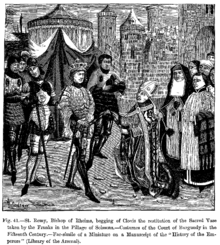
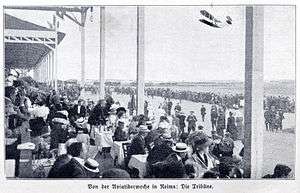
Before the Roman conquest of northern Gaul, Reims, founded circa 80 BC as *Durocorteron ("round fortress"; in Latin: Durocortōrum), served as the capital of the tribe of the Remi — whose name the town would subsequently echo. In the course of Julius Caesar's conquest of Gaul (58–51 BC), the Remi allied themselves with the Romans, and by their fidelity throughout the various Gallic insurrections secured the special favour of the imperial power. At its height in Roman times the city had a population in the range of 30,000 - 50,000 or perhaps up to 100,000.[2]
Christianity had become established in the city by 260, at which period Saint Sixtus of Reims founded the bishopric of Reims. The consul Jovinus, an influential supporter of the new faith, repelled the Alamanni who invaded Champagne in 336; but the Vandals captured the city in 406 and slew Bishop Nicasius; and in 451 Attila the Hun put Reims to fire and sword.
In 496 – ten years after Clovis, King of the Salian Franks, won his victory at Soissons (486) — Remigius, the bishop of Reims, baptized him using the oil of the sacred phial – purportedly brought from heaven by a dove for the baptism of Clovis and subsequently preserved in the Abbey of Saint-Remi. For centuries the events at the crowning of Clovis I became a symbol used by the monarchy to claim the divine right to rule.
Meetings of Pope Stephen II (752–757) with Pepin the Short, and of Pope Leo III (795–816) with Charlemagne (died 814), took place at Reims; and here Pope Stephen IV crowned Louis the Debonnaire in 816. Louis IV gave the city and countship of Reims to the archbishop Artaldus in 940. Louis VII (reigned 1137–1180) gave the title of duke and peer to William of Champagne, archbishop from 1176 to 1202, and the archbishops of Reims took precedence over the other ecclesiastical peers of the realm.
By the 10th century Reims had become a centre of intellectual culture. Archbishop Adalberon (in office 969 to 988), seconded by the monk Gerbert (afterwards (from 999 to 1003) Pope Silvester II), founded schools which taught the classical "liberal arts". (Adalberon also played a leading role in the dynastic revolution which elevated the Capetian dynasty in the place of the Carolingians.)
The archbishops held the important prerogative of the consecration of the kings of France – a privilege which they exercised (except in a few cases) from the time of Philippe II Augustus (anointed 1179, reigned 1180–1223) to that of Charles X (anointed 1825). Louis VII granted the city a communal charter in 1139. The Treaty of Troyes (1420) ceded it to the English, who had made a futile attempt to take it by siege in 1360; but French patriots expelled them on the approach of Joan of Arc, who in 1429 had Charles VII consecrated in the cathedral. Louis XI cruelly suppressed a revolt at Reims, caused in 1461 by the salt tax. During the French Wars of Religion the city sided with the Catholic League (1585), but submitted to Henri IV after the battle of Ivry (1590).
In the invasions of the War of the Sixth Coalition in 1814, anti-Napoleonic allied armies captured and re-captured Reims; in 1870–1871, during the Franco-Prussian War, the victorious Germans made it the seat of a governor-general and impoverished it with heavy requisitions.
In August 1909 Reims hosted the first international aviation meet, the Grande Semaine d'Aviation de la Champagne. Major aviation personages such as Glenn Curtiss, Louis Blériot and Louis Paulhan participated.
Hostilities in World War I greatly damaged the city. German bombardment and a subsequent fire in 1914 did severe damage to the cathedral. The ruined cathedral became one of the central images of anti-German propaganda produced in France during the war, which presented it, along with the ruins of the Cloth Hall at Ypres and the University Library in Louvain, as evidence that German aggression targeted cultural landmarks of European civilization.
_-_German_officers_sign_unconditional_surrender_in_Reims%2C_France._(Bottom)_-_Allied_force_leaders_at_the_signing._-_NARA_-_195337.tif.jpg)
(Top) – German officers sign unconditional surrender in Reims.
(Bottom) – Allied force leaders at the signing.
From the end of World War I to the present day an international effort to restore the cathedral from the ruins has continued. The Palace of Tau, St Jacques Church and the Abbey of St Remi also were protected and restored. The collection of preserved buildings and Roman ruins remains monumentally impressive.
.jpg)
During World War II the city suffered additional damage. But in Reims, at 2:41 on the morning of 7 May 1945, General Eisenhower and the Allies received the unconditional surrender of the German Wehrmacht. General Alfred Jodl, German Chief-of-Staff, signed the surrender at the Supreme Headquarters Allied Expeditionary Force (SHAEF) as the representative for German President Karl Dönitz.
The British statesman Leslie Hore-Belisha died of a cerebral haemorrhage while making a speech at the Reims hôtel de ville (city hall) in February 1957.
Sights
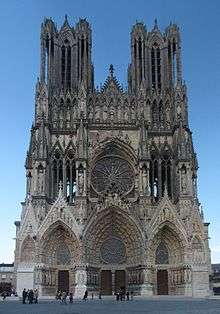
Streets and squares
The principal squares of Reims include the Place Royale, with a statue of Louis XV, and the Place Cardinal-Luçon, with an equestrian statue of Joan of Arc. The Rue de Vesle, the main commercial street (continued under other names), traverses the city from southwest to northeast, passing through the Place Royale. Restaurants and bars are concentrated around Place Drouet d'Erlon in the city centre.
Gallo-Roman antiquities
The oldest monument in Reims, the Porte de Mars ("Mars Gate", so called from a temple to Mars in the neighbourhood), a triumphal arch 108 feet in length by 43 in height, consists of three archways flanked by columns. Popular tradition tells that the Remi erected it in honour of Augustus when Agrippa made the great roads terminating at the city, but it probably belongs to the 3rd or 4th century. The Mars Gate was one of 4 Roman gates to the city walls, which were restored at the time of the Norman Invasion of northern France in the 9th century. In its vicinity a curious mosaic, measuring 36 feet by 26, with thirty-five medallions representing animals and gladiators, was discovered in 1860.
Note too the Gallo-Roman sarcophagus, allegedly that of the 4th-century consul Jovinus, preserved in the archaeological museum in the cloister of the abbey of Saint-Remi.
Cathedral of Notre-Dame de Reims
Many people know Reims for its cathedral, Notre-Dame de Reims, formerly the place of coronation of the kings of France. The cathedral became a UNESCO World Heritage Site in 1991, along with the former Abbey of Saint-Remi and the Palace of Tau.
Palace of Tau
The archiepiscopal palace, built between 1498 and 1509, and in part rebuilt in 1675, served as the residence of the kings of France on the occasion of their coronations. The salon (salle du Tau), where the royal banquet took place, has an immense stone chimney that dates from the 15th century. The chapel of the archiepiscopal palace consists of two storeys, of which the upper still (as of 2009) serves as a place of worship. Both the chapel and the salle du Tau have decorative tapestries of the 17th century, known as the Perpersack tapestries, after the Flemish weaver who executed them. The palace opened to the public in 1972 as a museum containing such exhibits as statues formerly displayed by the cathedral, treasures of the cathedral from past centuries, and royal attire from coronations of French kings.
Saint Remi Basilica
Saint Remi Basilica, about a mile from the Cathedral of Notre Dame of Reims, takes its name from the fifth-century Saint Remi — revered as the patron saint of the inhabitants of Reims for more than fifteen centuries. The basilica almost approaches the cathedral in size. Adjacent to the basilica stands an important abbey, formerly known as the Royal Abbey of St Remi. The abbey sought to trace its heritage back to St Remi, while the present abbey building dates back to the 17th and 18th centuries.
The Saint Remi Basilica dates from the 11th, 12th, 13th and 15th centuries. Most of the construction of the church finished in the 11th century, with additions made later. The nave and transepts, Gothic in style, date mainly from the earliest, the façade of the south transept from the latest of those periods, the choir and apse chapels from the 12th and 13th centuries. The 17th and 19th centuries saw further additions. The building suffered greatly in World War I, and the meticulous restoration work of architect Henri Deneux rebuilt it from its ruins over the following 40 years. As of 2009 it remains the seat of an active Catholic parish holding regular worship services and welcoming pilgrims. It has been classified as an historical monument since 1841 and is one of the pinnacles of the history of art and of the history of France.
Several royal and archepiscopal figures lie buried in the basilica, but in unidentified graves. They include:
- Carloman King of the Franks (751–771; reigned 768–771), the brother of Charlemagne
- Queen Frederonne (died 917), wife of Charles III (879–929)
- Gerberga of Saxony (910–984), wife of Louis IV (King of Western Francia from 936 to 954)
- Henri d'Orléans (died about 1653)
- Lothair I, (941–986), King of Western Francia from 954 to 986
- Louis IV (King of Western Francia from 936 to 954)
The public can visit the abbey building, now the Saint-Remi Museum. The abbey closed in the wake of the French Revolution (the government had all French monasteries dissolved in February 1790). The museum exhibits include tapestries from the 16th century donated by the archbishop Robert de Lenoncourt (uncle of the cardinal of the same name), marble capitals from the fourth century AD, furniture, jewellery, pottery, weapons and glasswork from the sixth to eighth centuries, medieval sculpture, the façade of the 13th-century musicians' House, remnants from an earlier abbey building, and also exhibits of Gallo-Roman arts and crafts and a room of pottery, jewellery and weapons from Gallic civilization, as well as an exhibit of items from the Palaeolithic to the Neolithic periods.
Another section of the museum features a permanent military exhibition.
Forts
In 1874 the construction of a chain of detached forts started in the vicinity, the French Army having selected Reims as one of the chief defences of the northern approaches to Paris. Atop the ridge of St Thierry stands a fort of the same name, which with the neighbouring work of Chenay closes the west side of the place. To the north the hill of Brimont has three works guarding the Laon railway and the Aisne canal. Farther east, on the old Roman road, stands the Fort de Fresnes. Due east, the hills of Arnay are crowned with five large and important works which cover the approaches from the upper Aisne. Fort de la Pompelle, which hosts a World War I museum featuring a rich collection of German uniforms, and Montbré close the southeast side, and the Falaise hills on the southwest are open and unguarded. The perimeter of the defences measures just under 22 miles, and the forts are at a mean distance of 6 miles (10 km) from the centre of the city.
Monument to the Black Army of Reims
The original monument was erected in 1924 where the Boulevard Henry Vasnier meets the Avenue du Général Giraud. The first stone was placed by André Maginot, Minister of War on 29 October 1922. This ceremony was also addressed by Blaise Diagne, the Senegalese political leader. In July 1924 the monument was inaugurated with a Military and Sports fete presided over by Édouard Daladier, the Minister of the colonies. General Louis Archinard was the president of the committee that supervised the erection of the monument, highlighting the role of African troops of the 1st Colonial Infantry Corps in the defense of Reims from the German Army in 1918. They were particularly renowned for their tenacious defence of Fort de la Pompelle. 10,000 people attended the fete which was held immediately following the inauguration. The original monument, consisting of five figures, was a replica of a similar monument erected in Bamako, Mali in January 1924. The monument was dismantled during the German occupation in September 1940. In September 1958, on the occasion of the fortieth anniversary of the Defence of Reims, a new monument was started. This was completed in time for a second inauguration ceremony on 6 October 1963, with Pierre Messmer, Minister of Armies, Jean Sainteny, Minister of veterans, Jacques Foccart, secretary general of the Communauté et les affaires africaines et malgaches, and General Georges Catroux, grand chancellor of the Légion d'honneur. In 2008, on the occasion of the ninetieth anniversary of the defence of Reims, a major ceremony was held in remembrance of the Black Army of Reims, attended by Jean-Marie Bockel, Rama Yade and Adeline Hazan.[3]
Other buildings
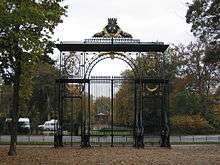
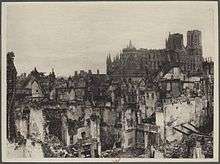
The Church of St Jacques dates from the 13th to the 16th centuries. A few blocks from the cathedral, it stands as of 2009 in a neighborhood of shopping and restaurants. What remains of the Abbey of St. Denis has become a Fine Arts Museum. The old College of the Jesuits also survives as a museum. The churches of St Maurice (partly rebuilt in 1867), St André, and St Thomas (erected from 1847 to 1853, under the patronage of Cardinal Gousset, now buried within its walls) also draw tourists.
The Temple protestant de Reims was designed by Charles Letrosne in a flamboyant neo-Gothic style. Originally the walls were lavishly decorated in Art Deco style by Gustave Louis Jaulmes, but in 1973 the walls were painted white, giving an austere appearance.[4]
The Foujita Chapel (1966), designed and decorated by the Japanese School of Paris artist Tsuguharu Foujita, became famed for its frescos. It was listed as an historic monument in 1992.[5]
The city hall (hôtel de ville), erected in the 17th century and enlarged in the 19th, features a pediment with an equestrian statue of Louis XIII (reigned 1610 to 1643).
The Surrender Museum is the building in which on 7 May 1945, General Eisenhower and the Allies received the unconditional surrender of the German Wehrmacht.
The Carnegie library, the former public library built with money donated by Andrew Carnegie to the city of Reims after World War I, is a remarkable example of Art Deco in France.
Transport
Reims is served by two main railway stations: Gare de Reims in the city centre, the hub for regional transport, and the new Gare de Champagne-Ardenne TGV 5 kilometres (3 miles) southwest of the city with high-speed rail connections to Paris, Metz, Nancy and Strasbourg. The motorways A4 (Paris-Strasbourg), A26 (Calais-Langres) and A34 intersect near Reims.
Public transport within the city consists of buses and a tramway, the latter opened in 2011.
Wine
Reims, along with Épernay and Ay, functions as one of the centres of champagne production. Many of the largest champagne-producing houses, known as les grandes marques, have their headquarters in Reims, and most open for tasting and tours. Champagne ages in the many caves and tunnels under Reims, which form a sort of maze below the city. Carved from chalk, some of these passages date back to Roman times.
Climate
| Climate data for Reims (1961–1990) | |||||||||||||
|---|---|---|---|---|---|---|---|---|---|---|---|---|---|
| Month | Jan | Feb | Mar | Apr | May | Jun | Jul | Aug | Sep | Oct | Nov | Dec | Year |
| Record high °C (°F) | 16.6 (61.9) |
21.6 (70.9) |
24.0 (75.2) |
29.4 (84.9) |
31.7 (89.1) |
35.4 (95.7) |
37.7 (99.9) |
37.3 (99.1) |
33.0 (91.4) |
27.5 (81.5) |
20.0 (68) |
16.7 (62.1) |
37.7 (99.9) |
| Average high °C (°F) | 4.9 (40.8) |
6.9 (44.4) |
10.2 (50.4) |
13.9 (57) |
18.1 (64.6) |
21.4 (70.5) |
23.8 (74.8) |
23.4 (74.1) |
20.3 (68.5) |
15.4 (59.7) |
9.2 (48.6) |
5.9 (42.6) |
14.5 (58.1) |
| Daily mean °C (°F) | 2.3 (36.1) |
3.4 (38.1) |
6.0 (42.8) |
8.9 (48) |
12.7 (54.9) |
15.9 (60.6) |
17.9 (64.2) |
17.7 (63.9) |
14.9 (58.8) |
11.0 (51.8) |
6.0 (42.8) |
3.2 (37.8) |
10.0 (50) |
| Average low °C (°F) | −0.4 (31.3) |
−0.1 (31.8) |
1.8 (35.2) |
3.8 (38.8) |
7.3 (45.1) |
10.4 (50.7) |
12.0 (53.6) |
11.9 (53.4) |
9.5 (49.1) |
6.6 (43.9) |
2.8 (37) |
0.5 (32.9) |
5.5 (41.9) |
| Record low °C (°F) | −22.3 (−8.1) |
−19.9 (−3.8) |
−10.8 (12.6) |
−5.5 (22.1) |
−2.1 (28.2) |
−0.4 (31.3) |
3.1 (37.6) |
2.0 (35.6) |
−0.7 (30.7) |
−6.6 (20.1) |
−11.5 (11.3) |
−19.6 (−3.3) |
−22.3 (−8.1) |
| Average precipitation mm (inches) | 43.6 (1.717) |
42.2 (1.661) |
50.8 (2) |
43.4 (1.709) |
59.8 (2.354) |
58.8 (2.315) |
52.2 (2.055) |
49.4 (1.945) |
49.5 (1.949) |
51.5 (2.028) |
53.1 (2.091) |
49.8 (1.961) |
604.1 (23.783) |
| Average precipitation days (≥ 1.0 mm) | 10.7 | 9.2 | 10.9 | 9.8 | 9.9 | 9.3 | 7.8 | 7.9 | 8.2 | 8.9 | 10.3 | 10.3 | 113.2 |
| Average snowy days | 5.6 | 4.9 | 3.4 | 1.4 | 0.1 | 0.0 | 0.0 | 0.0 | 0.0 | 0.0 | 2.0 | 3.9 | 21.3 |
| Average relative humidity (%) | 88 | 84 | 80 | 77 | 78 | 78 | 76 | 77 | 81 | 86 | 88 | 88 | 81.8 |
| Mean monthly sunshine hours | 50.3 | 86.1 | 129.4 | 171.7 | 206.9 | 220.0 | 235.0 | 216.3 | 170.6 | 121.6 | 71.9 | 49.0 | 1,728.8 |
| Source: Infoclimat.fr[6] | |||||||||||||
Sport
Between 1925 and 1969 Reims hosted the Grand Prix de la Marne automobile race at the circuit of Reims-Gueux. The French Grand Prix took place here 14 times between 1938 and 1966.
As of 2016 the football club Stade Reims, based in the city, competed in the Ligue 1, the first-highest tier of French football. Stade Reims became the outstanding team of France in the 1950s and early 1960s and reached the final of the European Cup of Champions twice in that era.
The city has hosted the Reims Marathon since 1984.
Notable residents
Those born in Reims include:
- Merolilan of Rheims, Irish cleric
- Guillaume de Machaut (1300–1377), composer and poet (Machaut was most likely born in Reims or nearby, and spent most of his adult life there)[7]
- Jean-Baptiste Colbert (1619–1683), who served as the French minister of finance from 1665 to 1683 during the reign of King Louis XIV
- Jean-Baptiste de la Salle (1651–1719), Catholic saint, teacher and educational reformer
- Nicolas de Grigny (1672–1703), organist and composer
- Jean-Baptiste Drouet, Count d'Erlon (1765–1844), marshal of France and a soldier in Napoleon's army
- Nicolas Eugène Géruzez (1799–1865), critic
- Adolphe d'Archiac (1802–1868), geologist and paleontologist
- Eugène Courmeaux (1817–1902), librarian of Reims and a fervent republican
- Olivier Métra (1830–1889), composer, conductor
- Émile Senart (1847–1928), indologist
- Paul Fort (1872–1960), poet
- Henri Marteau (1874–1934), violinist and composer
- Maurice Pézard (1876–1923), archaeologist and assyriologist
- Maurice Halbwachs (1877–1945), philosopher and sociologist
- Roger Caillois (1913–1978), intellectual
- Jean Baudrillard (1929–2007), cultural theorist and philosopher
- Patrick Poivre d'Arvor (born 1947), television journalist and writer
- Robert Pirès (born 1973), World Cup winner, footballer for Arsenal and for Villarreal CF
- Adeline Wuillème (born 8 December 1975), foil fencer
- Pauline Ferrand-Prévot (born 1992), World champion cyclist
Higher education
The URCA (University of Reims Champagne-Ardenne|Université de Reims Champagne-Ardenne) was created in 1548. This multidisciplinary university develops innovative, fundamental and applied research. It provides more than 18 000 students in Reims (22 000 in Champagne-Ardenne) with a wide initial undergraduate studies program which corresponds to society's needs in all domains of the knowledge. The university also accompanies independent or company backed students in continuing professional development training. The Institut d'Etudes politiques de Paris, the leading French university in social and political sciences, also known as Sciences Po, opened a new campus in the Collège des Jésuites de Reims in 2010. This Euro-American campus[8] will welcome more than 1500 students in 2015. In 2012 the first Reims Model United Nations was launched, which gathered 200 international students from all the Sciences Po campuses. Daniel Rondeau, the ambassador of France to UNESCO and a French writer, is the patron of the event. The Reims Management School is also one of the main schools in Reims.
International relations
Twin towns – sister cities
Reims is twinned with:
|
See also
- Archbishop of Reims
- Battle of Reims
- Biscuit rose de Reims
- Champagne (province)
- Champagne
- Champagne (wine region)
- Champagne Riots
- French wine
- Reims Aviation (aircraft-maker)
References
- ↑ "Reims," entry in Nouveau petit Larousse, 1971, p. 1638.
- ↑ de Planhol, X.; Claval, P. (1994). An Historical Geography of France. Cambridge University Press. p. 47. ISBN 9780521322089. Retrieved 10 October 2014.
- ↑ "Le monument à l'Armée noire de Reims" (in French). Retrieved 11 November 2010.
- ↑ Guttinger, Philippe (2015). "Le temple protestant de Reims". Retrieved 4 July 2015.
- ↑ "French Culture Ministry: listing of the Foujita chapel". culture.gouv.fr. Retrieved 16 August 2015.
- ↑ "Normes et records 1961-1990: Reims-Champagne (51) - altitude 91m" (in French). Infoclimat. Retrieved December 31, 2015.
- ↑ Oxford Music Online
- ↑ "Welcome | Sciences Po - College Universitaire de Reims - Campus Euro-Américain". college.sciences-po.fr. Retrieved 10 October 2014.
- ↑ "British towns twinned with French towns [via WaybackMachine.com]". Archant Community Media Ltd. Archived from the original on 5 July 2013. Retrieved 20 July 2013.
- ↑ Canterbury City Council – Twinning contacts. Retrieved on 14 October 2009. Canterbury.gov.uk (1 March 2011). Retrieved on 25 August 2011.
- ↑ Calderdale Council (2013). "Aachen: Twin towns: Calderdale Council". calderdale.gov.uk. Retrieved 2 January 2013.
- ↑ en-db (2013). "Aachen, Aachen, North Rhine-Westphalia, Germany – City, Town and Village of the world". en.db-city.com. Retrieved 3 January 2013.
- Attribution
 This article incorporates text from a publication now in the public domain: Chisholm, Hugh, ed. (1911). "Reims". Encyclopædia Britannica (11th ed.). Cambridge University Press.
This article incorporates text from a publication now in the public domain: Chisholm, Hugh, ed. (1911). "Reims". Encyclopædia Britannica (11th ed.). Cambridge University Press.
External links
| Wikimedia Commons has media related to: |
| Wikivoyage has a travel guide for Reims. |
- Official website (French)
- Tourist office website – Official site for L'Office de Tourisme de Reims, (English), (French)
- Sciences Po Paris – Euro-American campus of Reims
- Reims Model United Nations
- Joan of Arc and The Coronation Of Charles VII in Reims
- Joan of Arc's first letter to Reims — translation by Allen Williamson of the letter dictated by Joan of Arc to the city of Reims on 5 August 1429.
- Joan of Arc's second letter to Reims — letter dictated by Joan of Arc to the city of Reims on 16 March 1430, translated by Allen Williamson.
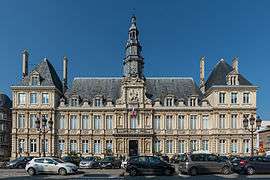

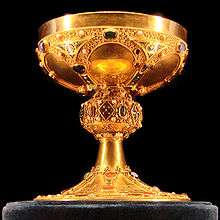
.jpg)